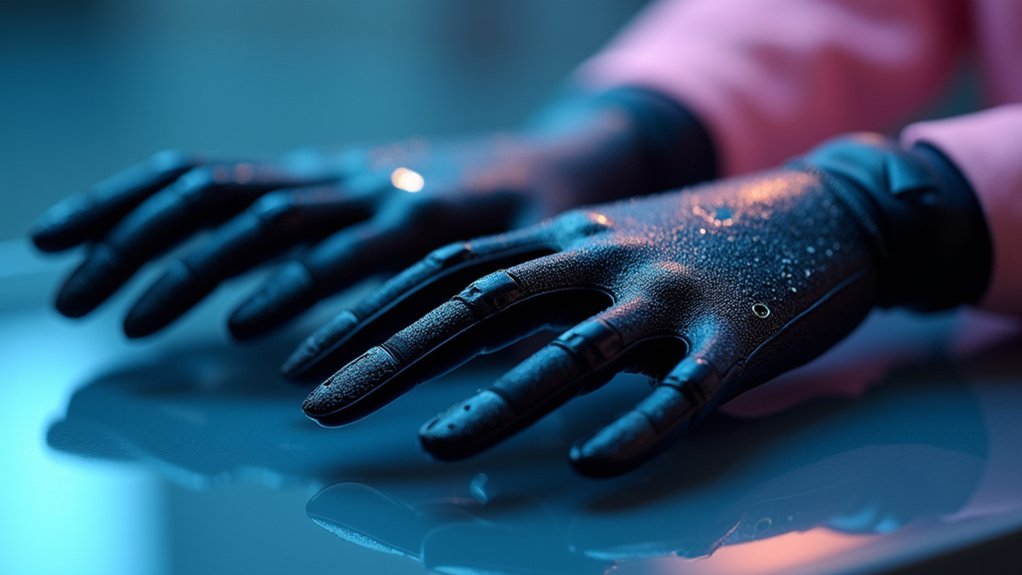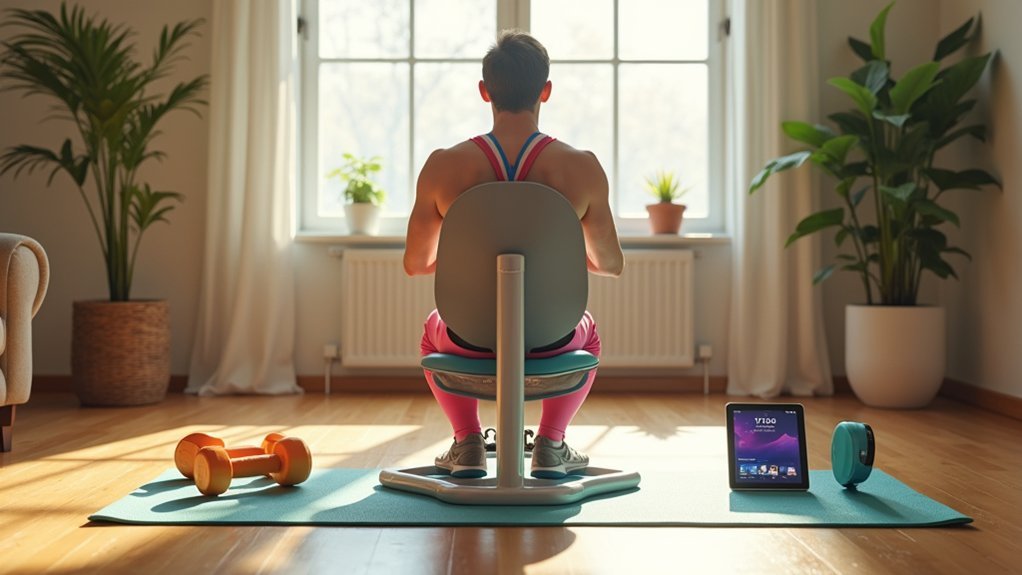You’ll discover ten game-changing innovations transforming adaptive haptic gloves: electroosmotic fluid arrays replacing bulky compressed air systems, ultra-high-resolution haptic pixels delivering 20 pixels per square centimeter, customizable electrical stimulation adapting to your neural sensitivity, self-contained wireless designs eliminating external equipment, advanced hand-tracking for real-time virtual object recognition, lightweight 207-gram construction with soft actuators, multi-disciplinary perceptual science combining visual-auditory-tactile feedback, dynamic texture simulation recreating complex surfaces, and professional applications enabling remote surgery. These breakthroughs promise to revolutionize how you’ll experience virtual environments.
Electroosmotic Fluid Arrays Replace Traditional Compressed Air Systems

While traditional haptic gloves relied on bulky compressed air systems, Fluid Reality’s revolutionary approach uses electroosmotic fluid arrays that’ll transform how you experience virtual touch.
Instead of needing cumbersome air canisters and extensive tubing, these Fluid Reality gloves utilize liquid to generate touch sensations through electrically-triggered small pumps. You’ll benefit from a remarkably compact design that eliminates external equipment entirely.
The electroosmotic fluid arrays deliver superior performance with 20 haptic pixels per square centimeter, creating high-resolution feedback you can actually feel.
Each ultra-slim actuator measures just 5mm thick while consuming only 10mW per pixel. At 207 grams total weight, you won’t experience the fatigue associated with traditional compressed air systems.
This self-contained approach guarantees seamless interaction without sacrificing the quality of your virtual touch experiences.
Ultra-High-Resolution Haptic Pixels Deliver Precise Tactile Sensations
The electroosmotic fluid arrays power an unprecedented level of tactile detail through ultra-high-resolution haptic pixels that’ll revolutionize how you perceive virtual objects.
With 20 haptic pixels per square centimeter, you’ll experience nuanced tactile sensations that blur the line between virtual and physical reality.
With 20 haptic pixels per square centimeter, you’ll feel virtual textures so realistic they’ll fool your fingertips completely.
- Precise electroosmotic responses – Each haptic pixel delivers exact fluid-based feedback for authentic touch experiences
- Shape-changing fingerpad arrays – High-resolution surfaces adapt to mimic various textures and materials you encounter
- 160 actuators across five fingers – Real-time, expressive feedback responds dynamically to your every interaction
- Enhanced object recognition – Improved detection of geometry, texture, and compliance creates truly immersive virtual reality experiences
This ultra-high-resolution design transforms how you’ll interact with digital environments through unprecedented tactile fidelity.
Customizable Electrical Stimulation Adapts to Individual Neural Sensitivity

You’ll experience customized haptic feedback through WeTac’s 32-electrode system that measures your unique electrical stimulation thresholds during initial calibration.
The glove adapts its intensity based on your individual nerve sensitivity levels, accounting for factors like gender differences and job-related hand conditioning that affect tactile perception.
This personalized approach guarantees you’ll receive ideal stimulation strength whether you’re experiencing gentle touches or sharp spike sensations in virtual environments.
Neural Threshold Calibration Methods
Because everyone’s hands respond differently to electrical stimulation, neural threshold calibration has become essential for creating truly personalized haptic experiences. Your haptic gloves need precise measurements to deliver ideal touch sensations tailored specifically to your hands.
The neural threshold calibration process involves several key factors:
- Individual sensitivity mapping – You’ll undergo testing to measure your unique electrical stimulation thresholds across different hand areas.
- Demographic considerations – Your age and gender influence calibration settings, with women typically requiring lower stimulation levels than men.
- Lifestyle assessments – Your job-related activities and daily experiences affect hand sensitivity levels.
- Physical hand conditions – Calluses on your hands increase stimulation thresholds, requiring stronger electrical signals.
The WeTac glove’s 32 electrodes adjust based on your personalized calibration data, ensuring consistent haptic feedback regardless of your individual neural sensitivity patterns.
Personalized Stimulation Intensity Control
When your WeTac glove powers on, its sophisticated control system automatically adjusts each of the 32 electrodes to match your specific neural sensitivity profile.
This personalized stimulation guarantees you’ll receive ideal feedback intensity based on your individual characteristics. If you’re a woman, you’ll typically require lower stimulation levels, while men generally need higher intensities. Your occupation matters too—if you have calloused hands from manual work, the system compensates with stronger adjustable electrical signals.
This customization transforms your user experience during virtual interactions.
You’ll feel gentle sensations when touching a virtual tennis ball and sharp feedback when encountering a cactus. The haptic technology’s ability to deliver precisely calibrated stimulation makes every virtual object feel authentically different, creating immersive experiences tailored specifically to your unique neural responses.
Self-Contained Wireless Design Eliminates External Equipment Dependencies
Traditional haptic systems tether users to bulky external equipment, but Fluid Reality’s innovative gloves shatter this limitation with their completely self-contained wireless design.
You’ll experience unprecedented freedom of movement without sacrificing tactile precision or functionality.
The self-contained architecture delivers multiple breakthrough advantages:
- Complete mobility freedom – No external tubing or wires restrict your movements during virtual interactions.
- Lightweight comfort – At only 207 grams including electronics and battery, you’ll forget you’re wearing haptic technology.
- Simplified setup – Everything’s integrated, so you won’t need additional equipment or complex configurations.
- Energy efficiency – Operating at just 10mW per pixel guarantees extended wireless sessions without frequent charging.
This wireless design transforms how you’ll interact with virtual environments, making haptic feedback truly portable and accessible for extended use.
Advanced Hand-Tracking Integration Enables Real-Time Virtual Object Recognition

While wireless freedom enables unrestricted movement, Fluid Reality’s advanced hand-tracking integration takes haptic interaction to the next level by enabling real-time virtual object recognition.
You’ll experience precise identification of your hand positions and interactions within virtual scenes through cutting-edge sensor technology. High-speed microfluidic processors deliver rapid actuator responses, providing instant real-time feedback when you manipulate virtual objects.
Sophisticated algorithms recognize object properties including geometry, texture, and weight, making your interactions remarkably realistic. This advanced hand-tracking considerably contributes to the immersion and natural control you’ll experience in virtual reality applications.
Continuous improvements in sensor technology and machine learning are refining accuracy and responsiveness, creating more immersive experiences that blur the line between virtual and physical manipulation.
Cost-Effective PCB Manufacturing Reduces Production Expenses Dramatically
Beyond delivering exceptional tactile feedback, Fluid Reality’s haptic gloves achieve remarkable affordability through innovative cost-effective PCB manufacturing that dramatically reduces production expenses.
You’ll benefit from standard manufacturing techniques that eliminate costly specialized equipment, making these adaptive haptic gloves accessible to broader markets.
Here’s how PCB manufacturing transforms production costs:
- Standard techniques – You’ll see significant savings using established PCB processes instead of expensive custom manufacturing.
- Compact electroosmotic arrays – You get lighter, simpler designs that reduce material costs and complexity.
- Electrical charge pumps – You eliminate bulky compressed air systems, cutting production expenses dramatically.
- Retail pricing under $1,000 – You access professional-grade haptic technology at 15x lower cost than competitors’ $15,000 alternatives.
This cost-effective approach enables widespread adoption across gaming and medical industries.
Lightweight Materials and Soft Actuators Maximize User Comfort
User comfort reaches new heights with Fluid Reality’s haptic gloves, which weigh just 207 grams including electronics and battery while delivering professional-grade tactile feedback.
You’ll experience unprecedented comfort through lightweight materials and ultra-slim 5mm actuators that eliminate traditional bulkiness. These soft actuators integrate seamlessly into an ergonomic design that doesn’t cause irritation during extended use.
WeTac’s innovative approach uses 32 electrodes with adjustable electrical signals, ensuring you can interact naturally without discomfort.
The integration of soft robotics techniques prevents heat-related issues common in mechanical actuators, making your experience consistently pleasant.
High-resolution shape-changing fingerpad arrays respond dynamically to your movements while maintaining the lightweight, ergonomic design that keeps you comfortable throughout prolonged sessions with haptic gloves.
Multi-Disciplinary Perceptual Science Combines Visual, Auditory, and Tactile Feedback
You’ll experience dramatically enhanced virtual interactions when haptic gloves integrate visual, auditory, and tactile feedback through cross-modal sensory integration.
Advanced perceptual research methods now reveal how your brain processes these combined sensory inputs, creating more realistic virtual object recognition.
This multi-disciplinary approach lets you perceive texture, weight, and material properties with unprecedented accuracy during virtual manipulations.
Cross-Modal Sensory Integration
When haptic gloves integrate visual, auditory, and tactile feedback simultaneously, they create a synergistic sensory experience that transcends what any single modality can achieve alone.
This cross-modal integration fundamentally transforms how you perceive and interact with virtual objects.
Research demonstrates that combining multiple sensory channels enhances your touch perception and creates more convincing virtual interactions.
Here’s how this integration works:
- Visual cues provide spatial context and object appearance
- Auditory feedback delivers texture sounds and interaction audio
- Tactile sensations offer physical properties like weight and resistance
- Synchronized timing guarantees all modalities align perfectly
Your brain naturally processes these combined inputs, creating richer haptic experiences than traditional single-channel feedback systems.
This sensory fusion makes virtual objects feel remarkably real and responsive.
Advanced Perceptual Research Methods
Multi-disciplinary perceptual science teams now employ sophisticated methodologies to decode how your brain processes combined sensory inputs from haptic gloves. Researchers use neuroimaging techniques to map cortical responses when you interact with virtual objects through tactile feedback systems.
They’re measuring reaction times, accuracy rates, and cognitive load across different sensory combinations to optimize haptic feedback delivery.
Advanced hand-tracking technology enables precise correlation between your movements and corresponding neural activity patterns. Scientists analyze how soft actuators influence your perception of texture, pressure, and temperature in virtual environments.
These studies reveal which sensory combinations create the most convincing illusions of physical interaction. By understanding your perceptual thresholds and integration processes, researchers can design more effective haptic systems that seamlessly blend reality with virtual experiences.
Dynamic Texture Simulation Recreates Complex Surface Properties
While traditional haptic devices deliver basic vibrations or simple force feedback, adaptive haptic gloves now recreate the intricate surface properties you’d feel when touching real materials.
Through dynamic texture simulation, these advanced gloves transform virtual environments into immersive tactile experiences that blur the line between digital and physical worlds.
The technology achieves this breakthrough through four key innovations:
- 160 ultra-slim actuators work together to deliver precise haptic feedback across your fingertips.
- 20 haptic pixels per square centimeter provide unprecedented texture resolution for complex surface properties.
- Shape-changing fingerpad arrays adapt in real-time to simulate everything from smooth glass to rough sandpaper.
- Dynamic pressure variation recreates material compliance, letting you feel soft fabrics or rigid metals convincingly.
Professional-Grade Applications Enable Remote Surgery and Hazardous Task Management
These texture simulation capabilities have opened entirely new frontiers in professional applications where precision and safety are paramount.
Haptic technology breakthroughs are creating unprecedented opportunities in critical fields where both accuracy and worker protection are essential.
You’ll find adaptive haptic gloves revolutionizing medical procedures, enabling surgeons to perform remote surgery with unprecedented accuracy. The tactile feedback you receive through electroosmotic fluid arrays creates realistic sensations that mirror actual surgical environments, allowing you to feel tissue resistance and texture variations from miles away.
Beyond medicine, you’re seeing these gloves transform hazardous task management. When you’re diffusing explosives or handling dangerous materials, the high-resolution shape-changing fingerpad arrays let you manipulate objects remotely while maintaining critical touch sensitivity.
These virtual interactions eliminate personal risk while preserving the fine motor control essential for complex operations. As affordability improves, you’ll witness widespread adoption across industries requiring both precision and safety.
Frequently Asked Questions
What Is the Expected Battery Life for Continuous Use of Haptic Gloves?
You’ll typically get 4-8 hours of continuous battery life with most haptic gloves, though this varies considerably based on the intensity of feedback you’re using and your specific device’s power management features.
Are These Haptic Gloves Compatible With Existing VR Headset Brands?
You’ll find most modern haptic gloves work seamlessly with popular VR headsets like Meta Quest, HTC Vive, and Valve Index through standard USB or wireless connections, though you should verify specific compatibility requirements.
How Do Users Clean and Maintain the Haptic Gloves Properly?
You’ll clean your gloves using antimicrobial wipes between sessions, avoiding moisture near sensors. Store them in provided cases, charge weekly, and perform monthly calibration checks to maintain peak performance and hygiene.
What Safety Precautions Should Users Follow When Wearing Haptic Gloves?
You should guarantee proper fit to prevent circulation issues, avoid excessive force that could damage sensors, keep gloves dry during use, and immediately remove them if you experience tingling or discomfort.
Can Haptic Gloves Cause Allergic Reactions or Skin Irritation?
You might experience allergic reactions to materials like latex, silicone, or synthetic fabrics in haptic gloves. If you’ve got sensitive skin, you’ll want to check material specifications and test gloves briefly before extended use.
In Summary
You’ll find these ten innovations transforming how you interact with virtual environments. Whether you’re performing remote surgery, training for hazardous tasks, or exploring immersive entertainment, these adaptive haptic gloves deliver unprecedented tactile realism. You’re no longer limited by bulky equipment or generic feedback systems. Instead, you’ll experience personalized touch sensations that adapt to your unique neural responses, creating seamless integration between digital and physical worlds that’ll revolutionize your professional and recreational activities.





Leave a Reply